25 Cereus Cactus Types (With Pictures)
-
Ed Malaker
- Last updated:
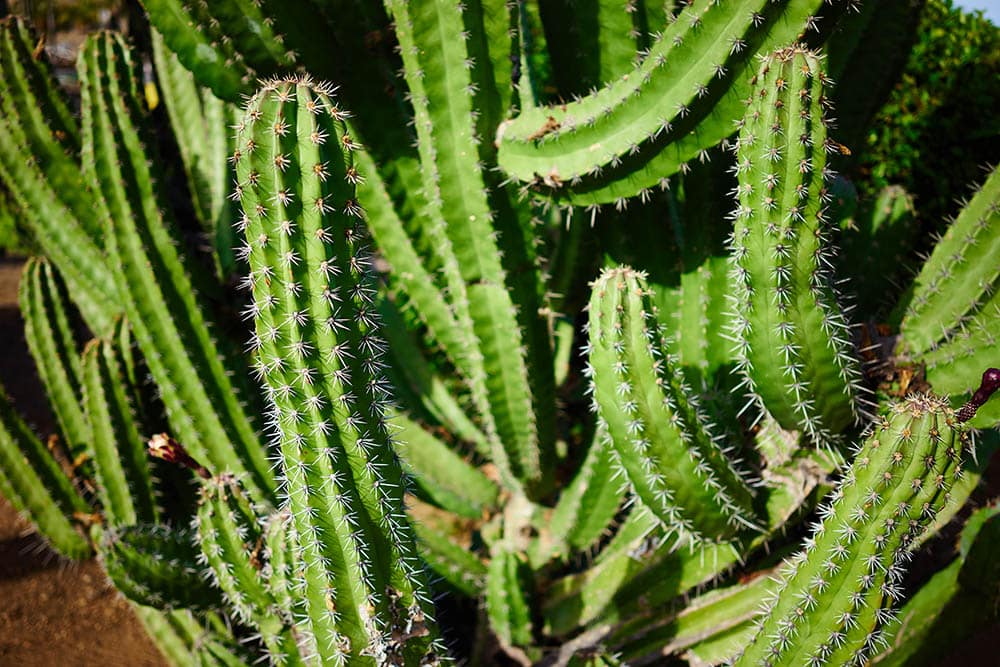
The Cereus Cactus is a popular night-blooming species of plant. According to the Royal Botanical Gardens, there were once 33 recognized species, but as of December 2021, there are only 25. Keep reading as we look at the different varieties to learn about their different traits and see which ones make good house plants.
The 25 Cereus Cactus Types
1. Cereus aethiops

| Hardiness Zone: | 9A–11B |
Cereus aethiops is a low-maintenance shrubby cactus with branches from the base that can reach 6.6 feet long and 3 inches in diameter. It produces fragrant white to pink funnel-shaped flowers that can be up to 8 inches long and 5 inches wide and are quite attractive.
2. Cereus ayisyen

| Hardiness Zone: | 9A–11B |
Cereus ayisyen is a shrubby cactus that is a native of Haiti. It can grow up to 13 feet tall, with 2.8-inch-long and 2.5-inch-wide flowers. It produces a green to yellow fruit that is about 4.4 inches long. It likes well-drained soil and plenty of sunlight.
3. Cereus bicolor

| Hardiness Zone: | 10A–11B |
The Cereus bicolor is a rare cactus with dark blue-green branches that can grow 10 feet tall. It produces red edible fruit and large white flowers that can be 8 inches long. It likes plenty of sun, so you will need to place it in a window and turn it frequently if you keep it indoors.
4. Cereus fernambucensis

| Hardiness Zone: | 9B–11B |
The Cereus fernambucensis is a cactus with thick, erect stems that can grow up to 6.6 feet tall, with a spread of more than 16 feet. It produces large, white, sweet-smelling flowers in summer, along with edible fruit.
5. Cereus forbesii
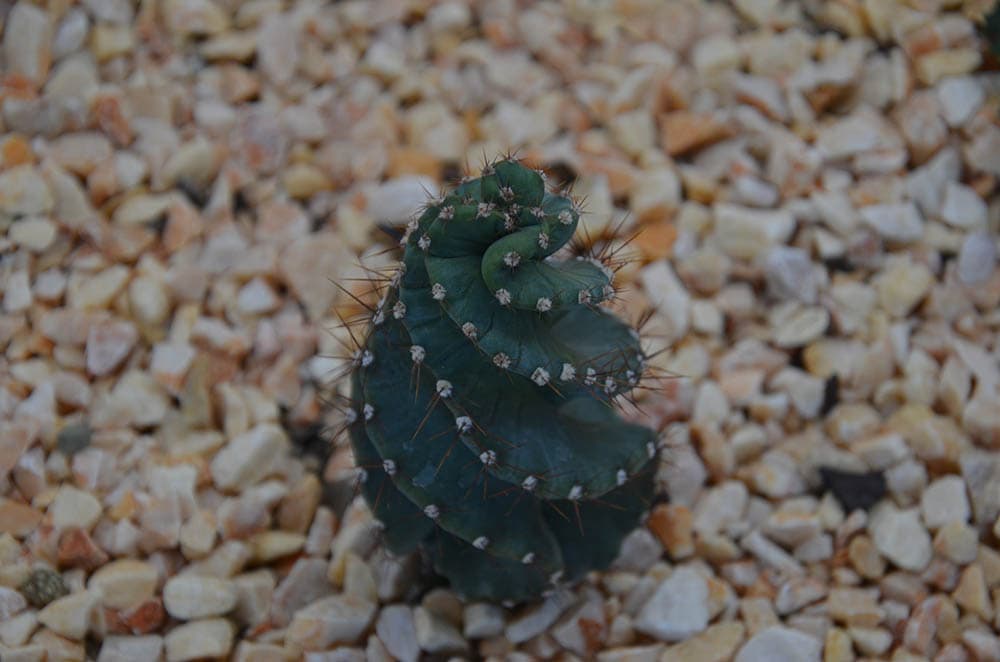
| Hardiness Zone: | 9B–11A |
Cereus forbesii is an unusual cactus with a naturally occurring mutant growth that caused many people to nickname it Ming Thing. It’s a slow grower that can get up to 1 foot tall with a club-like shape. It prefers well-drained soil and partial shade and produces purple and white flowers.
6. Cereus fricii

| Hardiness Zone: | 10A–11B |
Cereus fricii is a large tree-like cactus that often grows to more than 25 feet tall. It has dark-green branches and produces cream-colored flowers and pink fruit. It’s happiest in full sun and will require a window spot and frequent turning if you want to keep it inside.
7. Cereus hexagonus
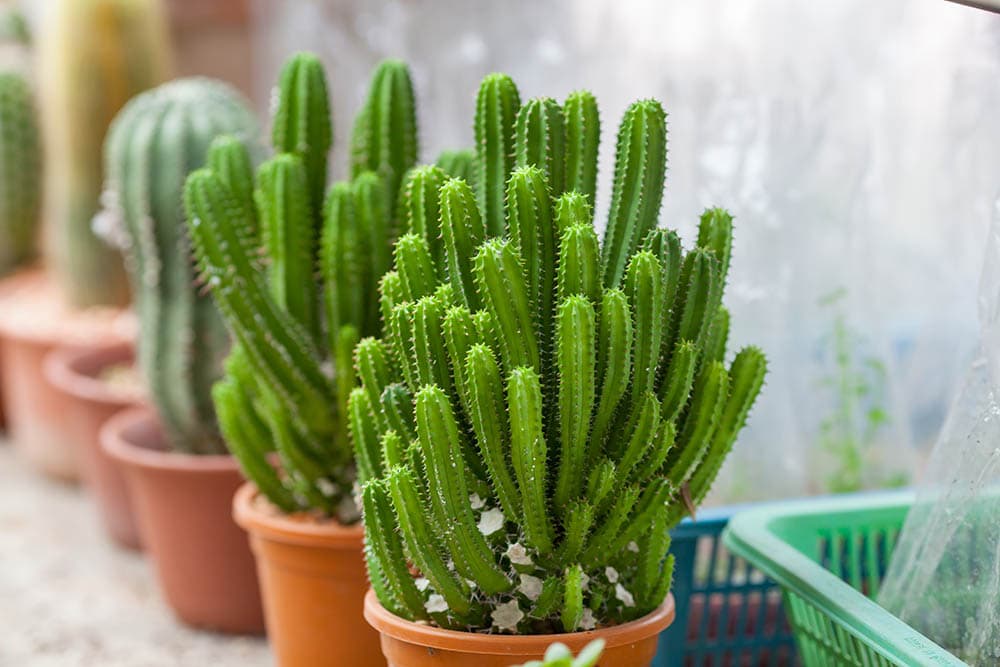
| Hardiness Zone: | 10A–11B |
Cereus hexagonus is a popular cactus with many common names, including Lady of the Night Cactus, Queen of the Night, and Blue Cereus. It’s one of the larger varieties and often grows to 50 feet, with large white flowers that can be 10 inches long. It also produces egg-shaped fruit that you can eat.
8. Cereus hildmannianus
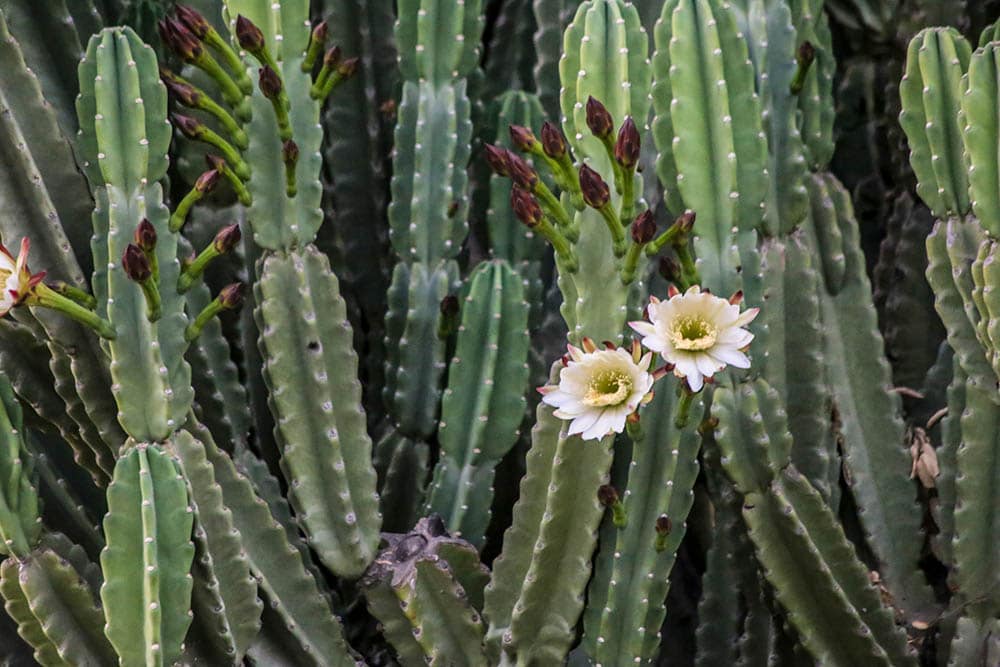
| Hardiness Zone: | 9B–11B |
The Cereus hildmannianus has many names, including the Hedge Cactus, Column Cactus, and Peruvian Apple Cactus. It’s native to South America and often grows 50 feet tall. It produces large white or yellow-white flowers that can be 1 foot long, as well as edible fruit. It likes plenty of sunlight but will tolerate partial shade.
9. Cereus horrispinus

| Hardiness Zone: | 9B–11B |
Cereus horrispinus is a tree-like cactus, but it’s smaller than many other varieties and only grows to about 16 feet tall. It produces white flowers and pink fruit. Like other varieties, it likes plenty of sunlight and well-drained soil.
10. Cereus insularis

| Hardiness Zone: | 9A–11B |
Cereus insularis is a small cactus that grows in clusters near the ground. The green stems have brownish yellow spines that can be .5 inches long. It produces yellow flowers at night during the summer and grows well indoors if you keep it in a sunny window.
11. Cereus jamacaru
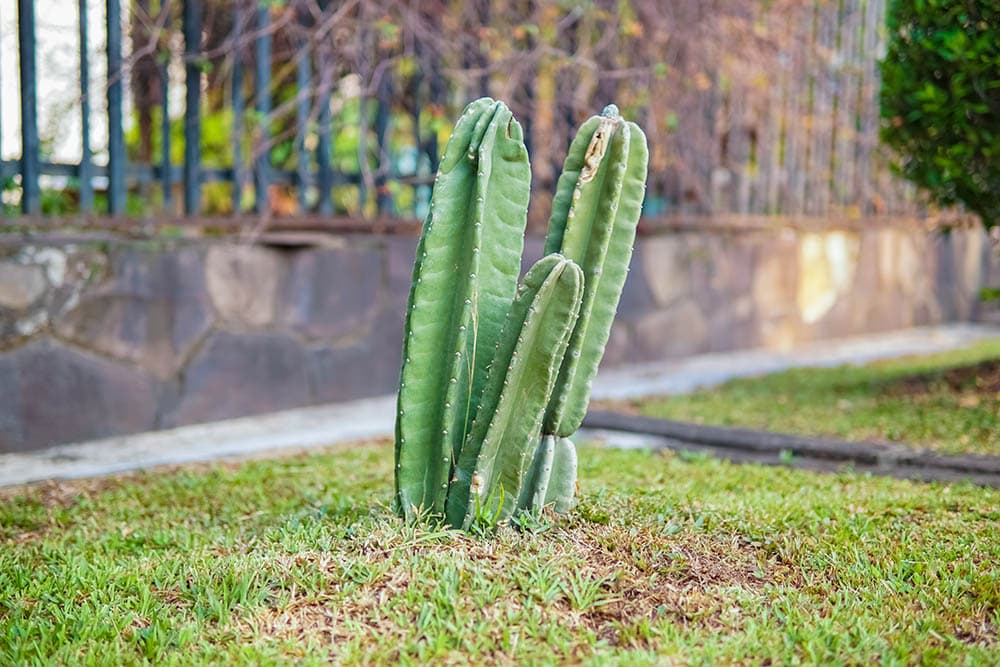
| Hardiness Zone: | 9B–11B |
The Cereus jamacaru comes from Brazil, grows up to 33 feet tall, and produces large white flowers that can reach 12 inches long and 9 inches in diameter. It also produces large edible berries that many people enjoy. It’s easy to grow, only requiring plenty of sunlight and well-drained soil.
12. Cereus lamprospermus

| Hardiness Zone: | 10A–11A |
Cereus lamprospermus is a large cactus that often grows up to 30 feet tall, producing white flowers. It’s easy to propagate using cuttings or even from seed, and it doesn’t require much maintenance if it gets plenty of sunlight.
13. Cereus lanosus
| Hardiness Zone: | 9B–11B |
Cereus lanosus is a species native to Paraguay that often grows to about 5 feet tall. It has orange spines that turn grey as the cactus gets older. The last part of its name means “wooly” and refers to the wool in the areoles where the spikes emerge. It usually produces white flowers throughout summer and into the fall.
14. Cereus lepidotus

| Hardiness Zone: | 9B–11B |
Cereus lepidotus is a rare cactus similar to Cereus hexagonus, and the two are easy to confuse. It can grow to 50 feet tall and will produce large, fragrant white flowers throughout the summer months.
15. Cereus mortensenii

| Hardiness Zone: | 10A–11A |
Cereus mortensenii is a large cactus that likes direct sunlight and often grows to 30 feet tall. It produces white or cream-colored flowers throughout the summer, along with edible fruit.
16. Cereus pachyrrhizus

| Hardiness Zone: | 10A–11A |
Cereus pachyrrhizus is a medium-sized cactus that usually grows 10–20 feet high. The flowers will be white and start blooming in late summer. It requires regular watering, but you must ensure that the soil is well drained, or the excess water can damage the roots.
17. Cereus phatnospermus

| Hardiness Zone: | 9A–11B |
Cereus phatnospermus is a cactus species with many small branches and clusters of brown spines. It can grow to over 6 feet tall and covers a large area. Like many other species of Cereus Cactus, it produces small red fruit and from spring until fall, white flowers at night that have a pleasant fragrance.
18. Cereus pierre-braunianus

| Hardiness Zone: | 9A–11B |
Cereus pierre-braunianus is a type of cactus that like to grow on the cliffsides of Brazil. It also makes a great houseplant. It has ascending segmented branches that can reach more than 20 feet tall. The branches lighten with age, producing white flowers that can grow to 6 inches long, along with small green to brown fruit.
19. Cereus repandus

| Hardiness Zone: | 9A–11B |
Cereus repandus has many names, including Giant Club Cactus, and it can often grow up to 33 feet tall in plenty of sunlight with regular fertilizing. The flowers that it produces are attractive and fragrant, with red highlights around the edge. The fruit is thornless and tasty.
20. Cereus saddianus
| Hardiness Zone: | 9A–11B |
Cereus saddianus is a tree-like cactus that grows to 20 feet tall, with greyish stems that can be more than 2 inches in diameter. Each plant will usually have eight or nine stems, with one central spine. Small white flowers give way to pink fruit in late summer.
21. Cereus spegazzinii

| Hardiness Zone: | 10A–11B |
Cereus spegazzinii is an easy-to-care-for cactus that produces attractive white-pink flowers from spring through fall, making it a popular choice for indoor gardens. Stems are cylindrical and can grow to more than 6 feet long. It produces many branches that can cover a large area in the wild.
22. Cereus stenogonus

| Hardiness Zone: | 9B–11B |
Cereus stenogonus is a columnar cactus that usually grows to more than 25 feet tall with cylindrical bluish-green or yellowish-green stems. The flowers are pink or red, and the fruit will be red or orange.
23. Cereus trigonodendron

| Hardiness Zone: | 9B–11B |
Cereus trigonodendron is a triangular-shaped columnar cactus that often grows to about 50 feet tall and will produce large flowers at the top. It’s native to Northern Brazil, Bolivia, and Peru but grows well in America with the proper care.
24. Cereus vargasianus

| Hardiness Zone: | 9B–11B |
Cereus vargasianus is a tree-like cactus with segmented branches and several central radial spines. It has white flowers and yellow fruit with white pulp. It grows well in direct sun and is easy to maintain.
25. Cereus yungasensis

| Hardiness Zone: | 10A–11B |
Cereus yungasensis is a species of cactus native to Bolivia. It has segmented branches that extend from the main stem, and it can grow to about 40 feet tall. The nocturnal flowers are reddish white and usually start to appear in mid-summer, when the temperatures are at their highest.
 Growing Tips
Growing Tips
- All species of Cereus Cactus require plenty of sunlight to reach their full size, though some can tolerate partial shade. If growing these cacti indoors, it’s best to put them in a southern-facing window where they will get plenty of sunlight and to turn them frequently so the entire plant receives direct light. LED full-spectrum lighting panels can also help get your plants the light that they need if they seem to be struggling.
- Adding a 10-10-10 fertilizer diluted to ¼ strength can help the cactus grow better.
- Make sure you use well-draining soil and water the cactus thoroughly, but let the soil dry out completely before you water it again.
Conclusion
There are many varieties of Cereus Cactus that you can grow in your home. All will do well in plenty of sunlight and well-drained soil, but they are easy to maintain otherwise. They produce fragrant and attractive flowers at night during the summer, and some varieties, like Cereus spegazzinii, will start producing flowers in the spring and will continue into the fall. Many varieties also produce edible fruit that you might enjoy.
- Royal Botanical Gardens
- World of Succulents
- World of Succulents
- World of Succulents
- World of Succulents
- NCSU
- World of Succulents
- World of Succulents
- World of Succulents
- Cactiguide
- World of Succulents
- World of Succulents
- Daves Garden
- World of Succulents
- LLIFLE
- Daves Garden
- Daves Garden
- World of Succulents
- World of Succulents
- World of Succulents
- Desert-Tropicals
- World of Succulents
- World of Succulents
- Detailedpedia
- World of Succulents
- World of Succulents
Featured Image Credit: marako85, Shutterstock
Contents

